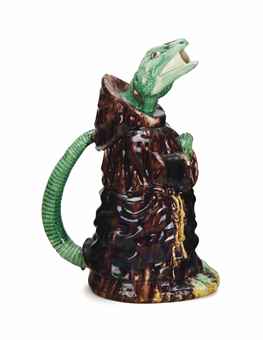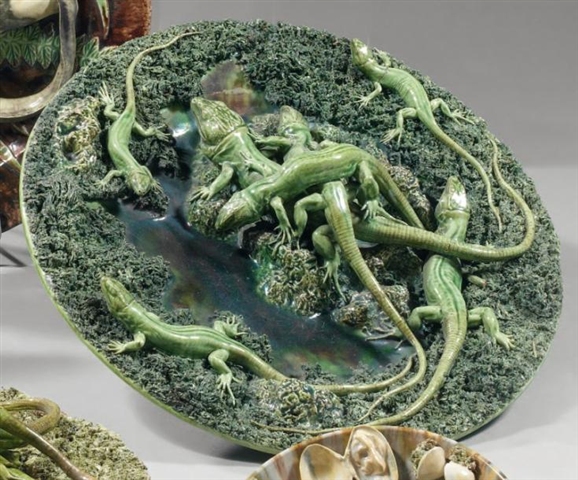Art World
Cold-Blooded Ceramics
In late 19th-century Portugal, there was a revival of Renaissance reptilian ceramic works.

In late 19th-century Portugal, there was a revival of Renaissance reptilian ceramic works.

Jenn Cortés

At artnet, we come across a lot of interesting lots in the Price Database. Sometimes it’s the kind of media that is used, the subject matter, or a combination of both that makes the work particularly remarkable. In early February 2013, a Christie’s Interiors sale included a Portuguese majolica ewer in the form of a lizard dressed as a monk.

A Portugese Majolica Ewer Modeled As A Lizard In A Monk’s Robes, Impressed Mark For M. Marfa Caldas, c.1880, sold at Christie’s Interiors, New York, NY
One might immediately imagine that this object came from an obscure Portuguese lizard cult. However, Christie’s identified the markings, not as a part of a secret religious order, but as a work by M. Mafra Caldas (Portuguese, 1829–1905), an artist who participated in the 19th-century revival of Palissy ware, a term used to describe ceramics produced in the style of 16th century potter, Bernard Palissy (Portuguese, c.1510–1589). Palissy attached casts of dead lizards, snakes, and shellfish to domestic items, such as plates or ewers, and glazed them in a variety of colors. Palissy’s interest in the natural environment was inspired by the discovery of the New World. While his contemporaries developed a fascination with the natural sciences, Palissy turned toward studying his own backyard.
The revival of Palissy ware began in 1853, with Manuel Cipriano Gomes, when he purchased a pottery factory in Caldas da Rainha, Portugal, and began producing pottery inspired by Palissy. After establishing his workshop, Gomes started operating under the name Mafra and soon became one of the most highly sought-after ceramicists in Europe. Unlike Palissy, Mafra’s work was characterized by images of violent struggles between animals in the wild. His mastery of the jasper technique, and his use of a larger palette of glazes, gave his work a more realistic appearance than Palissy’s. Developed by Josiah Wedgwood (British, 1730–1795) in 1775, Jasperware is a type of stoneware stained with metallic oxides. This technique, named for the mineral it resembles, became useful for Palissy ware artists who were trying to create smooth, realistic casts attached to pottery.
Mafra was only the first of many ceramicists in Caldas da Rainha to begin creating Palissy-inspired works. One of the more well-known followers of Palissy ware was Rafael Bordalo Pinheiro (Portuguese, 1846–1905), originally known in Portugal as a cartoon artist until he founded Fábrica de Faianças das Caldas da Rainha. Pinheiro became the artistic director of the factory, which eventually surpassed Mafra’s workshop in size and scale to become the largest producer of ceramics in the region. One of Pinheiro’s works, an eight-foot urn titled Jar to Beethoven, is now in the permanent collection of the Museum of Fine Arts in Rio de Janeiro, Brazil. Fábrica de Faianças produced commercial items as well as Palissy ware, but slow sales led to the factory’s closure in 1907, only a decade after Mafra’s factory had been shut down due to similar financial troubles. Despite the closure of both factories, Mafras and Pinheiros are still thought of as two of the most talented ceramicists of the 19th century.

Grand plat décoratif

Grand plat décoratif